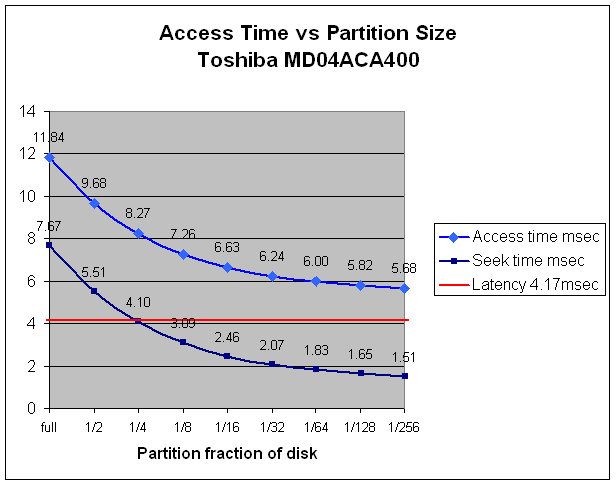First post, by shamino
- Rank
- l33t
I'm not really sure if this is the right forum section, but since it has general application to any PC, not just old ones, I decided to put it here.
Recently I was doing a simple performance test on a new hard drive. Then I decided to do some tests with reduced capacities.
Although I've seen a lot of internet discussions about short stroking drives, they seem to usually focus on linear transfer rate rather than access time. I think access time is a more important differentiator for desktop performance.
The internet discussions I was able to find about access time vs partition size were speculation/theory. I've been curious to see what realistic effect the partition size actually has on the access time of a real physical hard drive.
I did these tests on Linux Mint 17.1 using the utility 'gnome-disks'. It was configured to test 5000 random accesses. The results in the graph are the average access time for 5000 random locations with each partition size.
The drive is a modern Toshiba MD04ACA400 (4TB). It's connected to an AMD SB750 SATA2 chipset.
I tested the full disk (no partition created), then tested with smaller partition sizes on powers of 2. Each partition was created at the beginning of the disk, but due to the way sector alignment was handled, there are some very slight, insignificant deviations from the fractions shown on the graph.
The light blue line is the measured access time reported by the test. The other 2 values (head seek time and rotational latency) are the components which add up to the total access time. They are calculated based on the assumption that this drive spins at exactly 7200rpm. I don't know how firmly manufacturers actually adhere to that advertised number. The seek time is what is actually affected by changing the partition size.
The small end of the scale gets pretty absurd, but it can happen when using an oversized drive with an old retro PC.
This is a performance optimized drive (seeks are noisy). It might be interesting to do a similar test on a more conservative, quieter tuned drive. I can only assume they would follow the same curve, but maybe their programming would make the curve different.
I read a "rule of thumb" in a paper from the 1980s (obviously from the perspective of much older drive designs) which estimated a drive's seek time would vary in proportion to the square root of the distance. That seems to be a pretty decent estimate for the larger partition sizes, but it becomes increasingly inaccurate at the smaller end of the scale.
